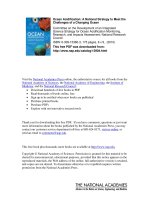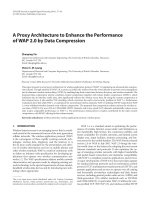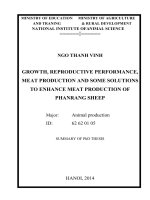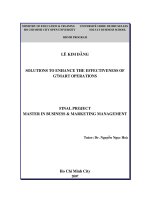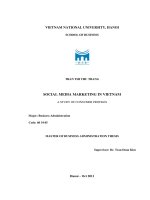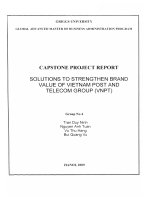social media strategy to enhance brand awareness of eugica
Bạn đang xem bản rút gọn của tài liệu. Xem và tải ngay bản đầy đủ của tài liệu tại đây (1.38 MB, 70 trang )
HO CHI MINH CITY OPEN UNIVERSITY
UNIVERSITÉ LIBRE DE BRUXELLES
SOLVAY BRUSSELS SCHOOL OF
ECONOMICS & MANAGEMENT
MMCoM9
PHAN LE HUONG LIEN
NGUYEN QUANG PHONG
SOCIAL MEDIA STRATEGY TO ENHANCE
BRAND AWARENESS OF EUGICA
MASTER FINAL PROJECT
MASTER IN MARKETING AND COMMUNICATION MANAGEMENT
Ho Chi Minh City
(2016)
1
STATEMENT OF AUTHENTICATION
We, the authors of this thesis - Phan Le Huong Lien and Nguyen Quang
Phong, confirm that we worked on it by ourselves with material retrieved from either
public sources or Mega We Care or Eugica brand. This paper was exclusively made
for the completion of the Master of Marketing and Communication at Solvay Brussels
School. No substance was or will be used for any other purpose.
2
ACKNOWLEDGEMENTS
First, we would like to thank our tutors, Professor Hoang Thi Phuong Thao and
Ms. Huynh Ba Chan Nhu, for their generous support and advice during the 3 months
that we worked on the thesis.
We would like to express our deepest gratefulness and most sincere
appreciation for all professors of Solvay Business School who always dedicate all
their time and passion to giving us an incredible amount of knowledge related to
Marketing and Communication Management. We believe that what we have learned
will contribute to our career success in the near future.
We would also like to thank our classmates in MMCOM9 class with whom we
studied and shared memorable moments both in and outside of class. Lastly, we
would like to send out warmest thank-you to the Eugica marketing team who provided
us with helpful information that enabled our completion of this thesis.
3
ACADEMIC TUTOR AND PRACTICAL TUTOR’S COMMENTS
Academic tutor’s comment
4
Practical tutor’s comment
The thesis which has been conducted by Phan Le Huong Lien and Nguyen Quang
Phong on the Social media strategy to enhance brand awareness of Eugica is
assessed qualified as a master degree thesis and to be presented to panels.
The thesis has been well-structured and profound analyzed on the market situation,
competition and market segmentation. Based on that, the conclusions and
recommendation for the brand‟s further development have been drawn out logically.
They includes both brand, marketing strategy and implementation. The social media
plan especially has developed trendy concept on green marketing which is found
contemporarily worthy for Eugica brand to pursue to pre-empt their competitors.
Though the thesis is still remarked limited in primary information from customers or
traders‟ perspectives in order to have a stronger supports to the social media strategy
in terms of content development.
On overall, the team has performed with high responsiveness and good attitudes with
their practical tutor to complete their work up to a satisfactory level.
Sincerely yours,
Huynh Ba Chan Nhu
5
TABLE OF CONTENTS
STATEMENT OF AUTHENTICATION
ACKNOWLEDGEMENTS
LIST OF CHARTS AND TABLES
LIST OF SYMBOLS AND ABBREVIATIONS
CHAPTER 1: INTRODUCTION.................................................................................. 10
1.1.
Rational of the study......................................................................................... 10
1.2.
Problem statement ........................................................................................... 11
1.3.
Objectives of the study ..................................................................................... 11
1.4.
Scope and limitation of the study...................................................................... 12
1.5.
Methodology ..................................................................................................... 12
1.6.
Structure of the study ....................................................................................... 13
CHAPTER 2: LITERATURE REVIEW ........................................................................ 14
2.1.
Brand and branding strategy ............................................................................ 14
2.1.1.
Brand Awareness ...................................................................................... 14
2.1.2.
Measuring brand awareness...................................................................... 15
2.1.3.
Brand equity............................................................................................... 15
2.1.4.
Brand identity and brand identity prism ...................................................... 16
2.1.5.
Branding strategy ....................................................................................... 18
2.2.
Social media ..................................................................................................... 18
2.2.1.
Social media‟s benefits .............................................................................. 18
2.2.2.
Social media strategy ................................................................................ 19
2.2.3.
Building a social media strategy ................................................................ 19
2.3.
Using social media to enhance brand awareness ............................................ 20
2.3.1.
Focus on the right social media channel .................................................... 21
2.3.2.
Optimize the social content strategy .......................................................... 21
2.3.3.
Strengthen the engagement strategy ......................................................... 21
2.3.4.
Social media advertising strategy .............................................................. 21
6
2.3.5.
Social media tracking tool .......................................................................... 22
2.3.6.
Social Media Analytics ............................................................................... 23
2.4.
Chapter summary ............................................................................................. 24
CHAPTER 3: EUGICA PROBLEM IDENTIFICATION ............................................... 25
3.1.
Situation review ................................................................................................ 25
3.1.1.
External analysis ........................................................................................ 25
3.1.2.
Internal analysis ......................................................................................... 33
3.1.2.1.
Mega Lifescience and Eugica brand background ................................ 33
3.1.2.2.
Marketing objectives of Eugica ............................................................ 36
3.1.2.3.
Marketing strategy ............................................................................... 36
3.1.2.4.
Analyzing Eugica marketing campaign in 2015 ................................... 42
3.1.3.
3.2.
SWOT analysis .......................................................................................... 48
Chapter summary ............................................................................................. 50
CHAPTER 4: SOCIAL MEDIA PLAN FOR EUGICA IN 2016..................................... 51
4.1.
Objective .......................................................................................................... 51
4.2.
Target Audience ............................................................................................... 51
4.3.
Communication concept ................................................................................... 56
4.4.
Communication plan......................................................................................... 57
4.5.
4.4.1.
Approach ................................................................................................ 57
4.4.2.
Communication strategy ......................................................................... 57
4.4.3.
Suggested action plan ............................................................................ 58
4.4.4.
Key Performance Indicator ..................................................................... 64
Chapter summary ............................................................................................. 67
REFERENCES........................................................................................................... 69
7
LIST OF SYMBOLS AND ABBREVIATIONS
No
List
Description
1
VND
Vietnam Dong
2
MS
Market share
3
OTC
Over the counter
4
TVC
Television commercial
5
PR
Public relations
6
KV
Key visual
7
Q
Quarter
8
DHG
Dược Hậu Giang ( Hậu Giang Pharma)
9
GMP
Good Manufacturing Practice
10
USP
Unique selling point
11
SEO
Search Engine Optimization
12
KPI
Key Performance Indicator
8
LIST OF PICTURES AND TABLES
List
Description
Chapter 2
Figure 2.1
Brand identity prism
Chapter 3
Figure 3.1
Market share and growth of top 10 cap and syrup brand
Figure 3.2
Production selection drivers per cough candy product
Figure 3.3
Market share and growth of top 10 OTC brand
Figure 3.4
Production selection drivers per cough medicine product
Figure 3.5
Vietnam Digital landscape 1
Figure 3.6
Vietnam Digital landscape 2
Figure 3.7
Vietnam Digital landscape 3
Figure 3.8
Vietnam Digital landscape 4
Figure 3.9
Eugica products including candy, syrup and soft cap
Figure 3.10
Eugica sale channel
Figure 3.11
Eugica‟s products and price
Figure 3.12
Summary of Eugica 360 degree marketing plan in 2015
Figure 3.13
Eugica marketing campaign 2015 in summary
Figure 3.14
The process of SMS system from Mega We Care
Chapter 4
9
Figure 4.1
Average daily usage of Internet/ Facebook of Vietnamese Youth in
2015
Figure 4.2
Popular communication tools of Vietnamese Youth in 2015
Figure 4.3
Eugica current Facebook Fanpage
Figure 4.4
Communication Strategy in 2016 in brief
Figure 4.5
Content direction – Mom‟s corner
Figure 4.6
Content direction – Youth‟s playground
Figure 4.7
Campaign KPI – Overall
Figure 4.8
Campaign KPI – Facebook Ads
Figure 4.9
Campaign KPI – Facebook Fanpage
10
CHAPTER 1: INTRODUCTION
This chapter provides an overview about this study including objective,
methodology as well as scope and limitation. Besides, it also presents the
methodology was used and the structure of the thesis.
1.1.
Rational of the study
Over the past couple of years, social media has matured from a novelty with
little practical business application into a recognized business driver. With increase
competition in the space and new social media advertising channels appearing
almost daily, it is more important than ever to envision, build and follow a sound social
media strategy that efficiently targets the audience into community members, brand
apostles and customers.
Acknowledge the revolution of Social Media that impacts directly to brand
communication, large pharmaceutical companies in Vietnam as Sohaco and Sanofi
establish a solid grasp of the uses and benefits of social media for their brands. They
understand that their target market is using social media, and that they need to
interact with customers by providing valuable content and engaging in meaningful
dialogue. For example, Acemuc – Sanofi‟s social media efforts are implemented in a
consistent manner across platform, and are congruent with their goal of being a
leader in customer service in the market. Answering questions and concerns promptly
on its Facebook Fanpage to show the human side of their employees, and
strategically promoting content across platforms are just few of elements of their
social strategy.
However, many others don‟t focus on developing social media as the main
platform of communication. They don‟t fully understand how to harness the power of it
to help them meet their specific business goal, and Eugica of Mega We Care is
among them. The social media activities of Eugica was still primitive and basic, which
unresolved the communication objectives then business goals of the brand. This is
the main issues that we need to solve in the study.
11
This thesis can help to identify the role of social media in both term of theory
and practice in supporting a specific pharmaceutical brand, which is Eugica to
enhance its awareness and the engagement with target audiences, by applying the
knowledge learned during the Master of Marketing and Communication course, and
practical experience from work of us.
1.2.
Problem statement
Although Mega Lifesciences became legal owners of Eugica in 2012, Mega
need to take a lot of steps to transform the image of Eugica. Recently, the trend of
using herbal medicine for cough treatment is becoming increasingly popular; thus,
Eugica slogan “Trị ho hiệu quả từ thảo dược” (Effective cough treatment from herbal)
is not a catchy and clearly one. Otherwise, its competitor like Prospan with the slogan
“Thuốc ho cho cả gia đình” (Cough medicine for family) and “Sản phẩm đến từ Cộng
Hòa Liên Bang Đức” (Product comes from Germany) can be known as the effective
way of marketing to consumers who always need to know the origin and the usage of
product. Beside, in present, the communication of Eugica is not clear because of the
transfer between DHG Pharmaceuticals and Mega We Care. If DHG only sells Eugica
to pharmacy not focus on communication, Mega We Care decides to invest more in
increasing brand awareness, brand image, affirming consumers of its credibility and
uplifting Eugica‟s market status.
Due to scale of this study, the study will focus to analyze Eugica
communication strategy through the campaign implemented in 2015 in order to know
what Mega We Care did to improve Eugica‟s brand awareness; then, coming to the
social media plan for the year of 2016 based on the success of this campaign.
1.3.
-
Objectives of the study
To analyze the Eugica‟s brand situation, including a review of its marketing
campaign in 2015.
12
-
To identify awareness of Eugica nationwide and differentiating values through
engagement-oriented activities.
-
To propose the solution to enhance brand awareness of Eugica in term of
social media strategy.
1.4.
Scope and limitation of the study
The purpose of the thesis is to analyze the current situation of Eugica in depth
and focus on ways to raise brand awareness, not to propose a solution related to
market share or sale target. Regarding the scope of timing with limited timeframe, this
study will focus on the time span of 2015 - 2016.To be able to develop a detailed
implementation plan, resources and information from other sources are required.
1.5.
Methodology
Both primary research and secondary research are used for the study.
Secondary research
Secondary research is collected from different sources such as industry
reports, organizational materials or market research data of market share, distribution
channels and other figures published in 2012, 2014 and 2015 from the company
discussed in the study or market research firms such as Euromonitor. Furthermore, to
acquire profound knowledge of marketing theory, academic sources such as books
are used for the study.
Primary research
In order to get information about the current situation, the issue Eugica faces
and vision for the future brand development of Eugica, in - depth interviews about
either Eugica situation or brand awareness or marketing objectives or activities have
been conducted with the following marketers of Eugica brand:
Ms. Cao Hoài My - Product Manager
13
Mr. Đặng Thanh Nghiệm - Marketing Department
Ms. Đinh Nguyễn Đài Trang - Marketing Department
1.6.
Structure of the study
Chapter 1: Introduction
This chapter provides an overview about this study including objective,
methodology as well as scope and limitation. Besides, it also presents the
methodology was used and the structure of the thesis.
Chapter 2: Literature review
This chapter is the review about theories which are used to apply for analyzing
Eugica brand. These theories include social media theory and brand identity as well
as brand awareness theory.
Chapter 3: Eugica problem identification
In this section, the study analyzes the situation of Eugica through the market
overview and some activities done in its marketing campaign in 2015. From these
findings, the thesis will evaluate its achievement and failure in term of the way of
delivering communication objectives and strategy to build brand awareness and
maintain its credibility.
Chapter 4: Social media plan for Eugica in 2016
In this chapter, a strategic social media plan will be proposed and applied to
both segments of Eugica, including Eugica Candy and Eugica Medicine (Syrup and
Capsule) in 2016.
14
CHAPTER 2: LITERATURE REVIEW
This chapter is the review about theories which are used to apply for analyzing
Eugica brand. These theories include digital marketing theory and brand identity as
well as brand awareness theory.
2.1.
Brand and branding strategy
A brand is a name, term, sign, symbol, or design or a combination of these that
distinguishes the manufacturer or seller of a product or service from its competitors
(Kotler et al. 2012).
2.1.1. Brand Awareness
The key objective of most businesses is to maximize their revenue. To achieve
this, it is important to attract customers and encourage repeat purchasing decisions.
Brand awareness refers to the perception of customers on a particular brand. To
successfully enhance brand awareness, the brand should be well-known and easily
recognizable. Besides, it is crucial that the business should differentiate its product
from its similar ones and competitors.
To be successful in the market, brand awareness plays an important role. In
fact, the more aware consumers are of the brand and its products, the more likely
customers make a purchase from that brand. When the company itself builds high
brand awareness, it translates into customer loyalty. If the customers‟ positive
associated with their knowledge of the brand, customer loyalty will be stronger.
The major components of a plan to develop brand awareness are:
-
Identifying and understanding the target customers
-
Creating a company name, logo, and slogans
-
Adding value through packaging, location, service, special events, etc.
-
Advertising
-
After-sale follow-up and customer relation management
To significantly enhance brand awareness, the business should:
15
-
The message that a brand conveys to the consumer should be consistent.
-
Brand images should also be consistent in order to easily increase brand
awareness. It is important that brand images are consistent, thereby maximizing
recognition and positive impressions.
-
Slogans and taglines should also be consistent throughout mediums and
material. Marketers should observe how customers response to the product,
packaging, displays and messages in order to improve the image immediately.
2.1.2. Measuring brand awareness
-
In order to measure brand awareness, marketers should conduct a survey to
ask the respondent to name all the brands which he/she associates with a given
product category. Then question is also to ask him/her to pick from a list the brands
he/she recognizes. Consequently, the marketer can obtain three brand recall
indicators:
-
Spontaneous brand recall – the brands named by the consumer himself/
herself. These are the ones from among which the consumer chooses when buying
the product of a given category. Spontaneous brand recall thus defines the
consumer‟s selection range.
-
Top-of-mind recall – the brand first named by the consumer himself/herself.
This brand is attributed the highest value – when choosing which product to buy the
consumer will probably pick a product of this brand. The strength of the consumer‟s
emotional link with the brand is better reflected by the brand named first than by
spontaneous recall.
-
Aided recall – recognition of a given brand among others. The spontaneous
recall means that the consumer remembers the brand, whereas the aided recall
shows that the consumer is only able to recognize it. Aided recall indicates a weak
link to the brand on the part of the consumer. Brand awareness is a measure of the
effectiveness of a company‟s marketing activity.
2.1.3. Brand equity
16
Brand equity refers to the commercial value that receives from consumer
perception of the brand name of a particular product or service, rather from the
product and service itself. A high brand equity offers many competitive advantages to
the company. Firstly, the business can gain high level of consumer brand awareness
and customer loyalty. Furthermore, it is easier for the firm to leverage in bargaining
with resellers and launch line and brand extensions. In addition, it defenses against
fierce price competition. Lastly, it provides the basis for establishing strong and
profitable customer relationships (Armstrong et al. 2006).
2.1.4. Brand identity and brand identity prism
Brand identity looks like a message that the business wants its customers to
perceive. All components of the brand such as name or logo are designed to reflect
the value that company strives to bring to the market and attract its customers (Barsy
2015).
Brand identity prism (Kapferer) with six aspects includes (Barsy 2015):
17
Figure 2.1: Brand identity prism
Source: Adapted from Building and managing brands (2015)
-
Physique is the set of the brand‟s physical features, which immediately comes
to mind when the brand name is mentioned.
-
Personality is the brand‟s character. This can be realized by using a famous
character or celebrity experts to give the brand a spokesperson.
-
Culture represents the values and principles a brand stands for.
-
Relationship shows the way each communication relates to its target audience
or how brands influence and provide a particular service to its customers.
-
Customer reflection means how a customer reflects with a brand.
-
Self-image explains how a customer perceives himself by using the brand.
-
Understanding the identity prism can help to position each brand better and
create effective marketing strategy. If the identity is clearly understood, the brand will
be well communicated.
18
2.1.5. Branding strategy
Branding is an important attribute of the product mix strategy. Marketers
should develop a product into a brand, which helps win customer loyalty, recall and
differentiate itself in the market. Branding decisions remain one of the most important
factors as it turns a product into something beyond just a functional good. A brand
can have the power to generate instant sales as well generate confidence in the
product‟s quality (Palmer et al. 2012).
The branding strategy is to help consumers identify products, to say something
about product quality, to protect legally, to segment the market and to command a
premium for better quality brands (Palmer et al. 2012).
2.2.
Social media
Social media is a form of internet marketing that implements various social
media networks in order to achieve marketing communication and branding goals.
Social media marketing primarily covers activities involving social sharing of content,
videos, and images for marketing purposes as well as paid social media advertising
(Kerpen 2013).
2.2.1. Social media’s benefits
According to Meyerson (2015), many business owners understand that their
target market is using social media, and that they need to interact with customers by
providing value content and engaging in meaningful dialogue. However, many
business owners don‟t fully understand how to harness the power of social media to
help them meet their specific business goals. There are a number of very real
benefits to using social media for business, including:
-
Reputation monitoring and management
-
Branding
-
Building customer loyalty
-
SEO benefits
19
-
Website referral traffic
2.2.2. Social media strategy
Meyerson (2015) implies that a basic social media strategy based on the goals of
using social media will typically include:
-
An overview of the sites you will be using (Facebook, Twitter, etc.)
-
A content generation plan
-
A growth or promotion plan
-
A conversion strategy
2.2.3. Building a social media strategy
Before starting to create social media strategy, the planner needs to carefully
look at the many factors that will affect and limit his plan in order to ensure the
effectiveness of his strategy (Kerpen 2013).
Understand your goals: the first step in creating a social-media marketing
strategy is to understand where you want to go. What is the purpose of your social
media marketing efforts? Do you want to create or raise awareness of your brand?
Are you looking to increase sales, or website traffic, or both? Is your goal to build
customer loyalty and increase retention?
Create measurable objectives: Focus on the S.M.A.R.T. strategy for goal
setting to ensure the objectives are specific, measurable, attainable, relevant and
time based. Besides, finding the right tools to track and analyze each objectives can
help the company quantify the progress. From that, it is good to know the problems
early and adjust them if needed.
Characterize your customers: A successful social-media strategy is all about
targeting the right people with the right messages. The best way to do this is to create
buyer personas. Therefore, a detailed profile of ideal customer need to be identify.
Some information needed are customer‟s name, age, income, marriage status,
children, their hobbies or interest, etc.
20
Look at the competition: when it comes to social media, the competition can
tell a lot about what works and what doesn‟t. To research the competitors, the
company should start by picking three or four of the top ones. Then, find out which
social networks they‟re active on, and study their content.
Develop the messages: Choose two or three messages, then break each one
down another level creating a simple messaging hierarchy.
Choose the channel: The company need to choose the right ones for the
products or services it is selling. Besides, the company should also identify
influencers who can reach target audience.
Build a content plan: Develop a strong content plan that will deliver engaging
material is also the important step. The content needs to align with overall messaging
and be appropriate for the channels used. This is more than just product information;
it need to deliver real value to your audience.
2.3.
Using social media to enhance brand awareness
In the past, traditional media is a king of communication strategy. However,
traditional media delivers a single message through one-way communication to the
largest audience possible. It can deliver that message through any number of media,
but that one message goes out while the advertiser waits and “hopes it sticks”.
Otherwise, social media delivers several messages through two-way communication
to an audience that is interested in the brand. Those messages may be delivered
through blogs, Twitter feeds or Facebook posts, but the goal of each message is to
generate a response from the user.
In this recent days, many companies understand that using social media for
marketing can enable them looking to further their reach to more customers.
Customers are interacting with brands through social media, therefore, having a
strong social media marketing plan and presence on the web is the key to tap into
their interest. If implemented correctly, marketing with social media can bring
remarkable success to business (Meyerson 2015).
21
2.3.1. Focus on the right social media channel
Based on consumer sex, social status, interests and other demographic, the
company can choose the suitable social network. Targeting a social network based
on the number of active users in each platform sometimes will not the best choice if
the brand targets a particular type of customer. Besides, enhancing brand awareness
can depend on the geographical location which the campaign focus on (Kerpen
2013).
2.3.2. Optimize the social content strategy
This step will enable company to create interesting content topics that goes
viral are liked, shared, and commented on by targeted audiences. These types of
content can be funny, educational, controversial and visual – practically anything
under the sun in order to attract the audiences (Kerpen 2013).
2.3.3. Strengthen the engagement strategy
Another way to boosting brand awareness through social media is to establish
a good engagement with targeted audiences. Through engagement, the company
can interact with its targeted audiences about its business, products or services, or
even to directly respond to inquiries, concerns or complaints (Meyerson 2015).
Aside from the content, choosing the right timing is key to reach the highest
potential in engaging with customers during peak social media usage. For example,
the higher usage will be from 1 to 3 pm, or during Thursday and Friday (Meyerson
2015).
2.3.4. Social media advertising strategy
The activities company use for social media marketing may not be enough to
boost brand awareness; therefore, using paid social media advertising will help to
expand the campaign better. Although social media can be free, making use of paid
22
advertising channels such as Facebook ads, LinkedIn advertising or Twitter‟s
promoted tweets can get the brand right in front of highly targeted audiences who
potentially become paid customers (Kerpen 2013).
Some examples of specific goals are:
To increase page views by 10 percent this quarter
To grow market share by 5 percent this year
To increase the website conversion rate to 5 percent
Social media is a powerful and very effective tool for driving targeted traffic
engagement, conversions and even sales from the growing number of active users
accessing their social network accounts through their laptops or mobile devices.
Therefore, with a right social media strategy, the brand awareness will be increasing
effectively (Kerpen 2013).
Here‟s some of the biggest advantages of a great social media strategy,
according to Forbes:
Better brand recognition.
Increased brand loyalty.
Better conversion rates.
More inbound traffic.
Improve search engine rankings.
Increased marketing ROI.
Better customer insights.
2.3.5. Social media tracking tool
One of the most important parts of social media is engagement. When people
are talking about brand, or topics that interest the brand, it‟s an opportunity to engage.
These social media tracking tools allow company to track these conversations as they
occur, giving the chance to leverage each brand.
Most applications will provide the necessary tools to manage all profiles from
one easy dashboard. This includes Facebook, Twitter, Pinterest, LinkedIn, Google+,
23
Slide Share, YouTube, blogs, and message boards. Company can easily track
mentions, likes, and comments.
Applications such as Unmetric take it further as it enables company to monitor
the activities of the competition as well. Company will see what content is the most
effective with historical data. This will help company plan its campaigns more
effectively in the future.
Most importantly, the tools will allow company to measure the effectiveness of
the campaigns. Company will be able to track how much activity its posts are getting,
and how that traffic is driven. It can track results across multiple platforms, and know
where to focus in the future. Social media tracking tools let company go beyond
figuring out what the audience is talking about, and let company figure out where
they‟re talking about it. Company will be able to quickly figure out what the most
effective platforms are, and focus its efforts there.
2.3.6. Social Media Analytics
Monitoring the social media analytics can make the difference between the
success or failure of the social media presence. Some elements what the company
needs to be monitoring and outline a range of tools for social media analysis and
reporting.
Audience Size
Audience Profile
Reach and Engagement
Traffic
Content Analysis
Community Responsiveness
Competitor Benchmarking
Example for tool used for Social Media Analytics: Google Analytics is a
very comprehensive web analytics tool that most of company are familiar. Here are
some of the main features in relation to social media analytics.
24
Track traffic from social platforms – Company can drill down by referrer
and look at the traffic generated from each of the social platforms. If company use a
custom URL, company can track traffic generated from a specific link you shared.
Isolate traffic using a segment – If company want to drill down on traffic
for a particular channel, company can create a segment and view information just
related to that channel.
Social media dashboard – Create a graphical dashboard that shows a
summary of the social media activity and the results of traffic generated.
View real-time traffic – When company share out content on social
media, company can view the website traffic in real-time.
Social media conversions – Companh can set up goals and track the
conversion rates of these goals broken down by social channel.
2.4.
Chapter summary
In conclusion, the theories mentioned above such as brand awareness, brand
identity, social media are the foundation to analyze the current company situation.
Then, the thesis proposes some suggestions in term of social media to enhance the
brand awareness of Eugica.

